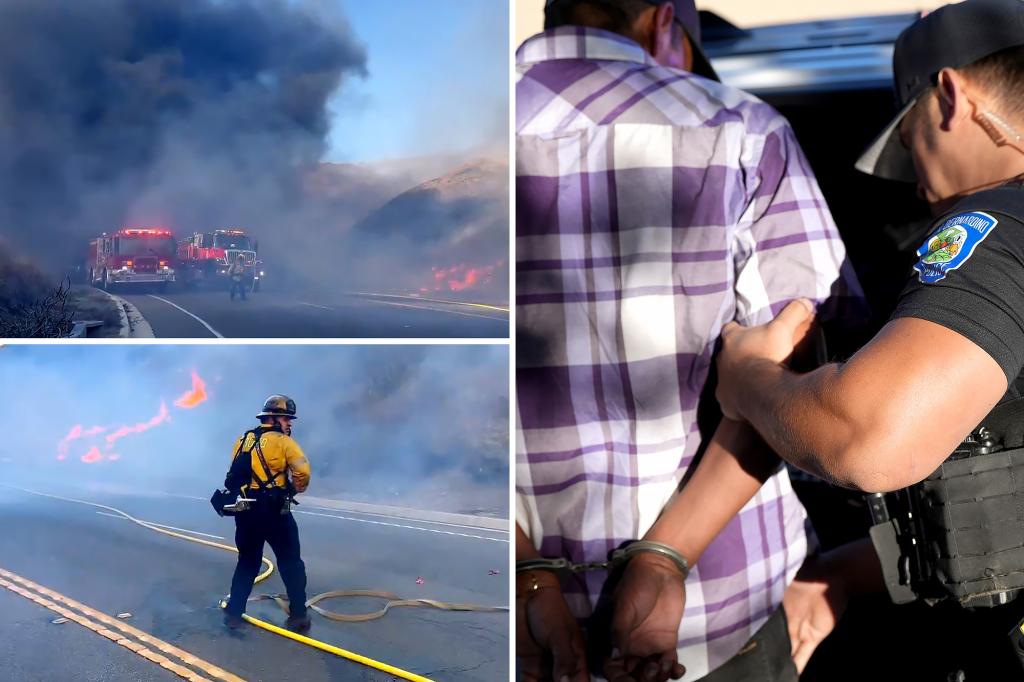The San Bernardino Brushfire Incident: A Case of Reckless Burning Amidst Regional Wildfires
On Wednesday afternoon, a brushfire erupted near Little Mountain Drive and Edgehill Drive in San Bernardino, California. The blaze, which ignited around 2 p.m., swiftly spread across 34 acres before firefighters successfully halted its progress by 3:30 p.m. Fortunately, the fire’s duration was short-lived, resulting in no structural damage or injuries. San Bernardino police apprehended a man at the scene and charged him with two felony counts, including reckless burning, in connection with the fire’s origin. The suspect’s identity has not yet been disclosed to the public. This incident occurred amidst a backdrop of devastating wildfires that have ravaged parts of Los Angeles and the surrounding areas, raising concerns about the potential for further outbreaks.
The Context of Regional Wildfires: A Season of Destruction and Loss
The San Bernardino fire occurred within a larger context of widespread wildfires plaguing Southern California. These infernos have consumed vast swaths of land, primarily in Los Angeles County, where over 37,000 acres have been scorched. The destructive path of these fires has left a trail of devastation, claiming the lives of at least 25 people and rendering more than 10,000 homes and businesses uninhabitable. The scale of destruction marks these fires as a historic event, underscoring the vulnerability of the region to such natural disasters. The ongoing efforts of firefighters to contain these blazes are crucial in preventing further loss of life and property.
The Issue of Arson: A Threat Amplified by Dry Conditions
The arrest in San Bernardino highlights the issue of arson, a serious concern during wildfire season. Authorities in Los Angeles have apprehended four individuals over the past week on arson charges related to attempts to ignite new fires outside existing wildfire zones. These arrests underscore the heightened risk of arson during periods of dry vegetation and high winds, conditions that can rapidly escalate a small fire into a raging inferno. The intentional setting of fires not only poses an immediate danger to lives and property but also diverts crucial firefighting resources away from battling naturally occurring blazes. The consequences of arson during such vulnerable times can be catastrophic and necessitate a vigilant response from law enforcement agencies.
The Impact on Communities and Resources: A Struggle for Containment and Recovery
The wildfires currently ravaging Southern California have placed immense strain on communities and resources. Thousands of residents have been forced to evacuate their homes, seeking refuge in shelters and temporary accommodations. The displacement and uncertainty surrounding their future create a significant emotional and financial toll. Firefighting resources, including personnel and equipment, are stretched thin as crews battle multiple blazes simultaneously. The ongoing efforts to contain these fires require a coordinated response from various agencies, including local fire departments, state agencies, and federal assistance. The aftermath of these fires will necessitate a long and arduous recovery process, involving rebuilding homes, restoring infrastructure, and providing support to affected communities.
The Importance of Fire Prevention and Preparedness: Lessons Learned and Future Strategies
The current wildfire crisis emphasizes the importance of fire prevention and preparedness. Individuals can take proactive steps to reduce the risk of fire on their properties by creating defensible space around their homes, clearing brush and debris, and following fire safety guidelines. Community-wide efforts, such as implementing fire-resistant landscaping and developing evacuation plans, can further enhance fire safety. Public awareness campaigns can educate residents about the dangers of wildfires and promote responsible behavior during periods of high fire risk. Investing in advanced firefighting technologies and resources, such as early detection systems and aerial firefighting capabilities, can strengthen the region’s ability to respond effectively to future fire threats.
The Need for Long-Term Solutions: Addressing Climate Change and Land Management Practices
The increasing frequency and intensity of wildfires in California highlight the need for long-term solutions that address the underlying causes of these events. Climate change, with its associated rise in temperatures and prolonged droughts, contributes to the creation of dry and flammable landscapes. Adopting policies to mitigate climate change through reducing greenhouse gas emissions is crucial in curbing the long-term risk of wildfires. Sustainable land management practices, including controlled burns and forest thinning, can also play a role in reducing fuel loads and preventing catastrophic fire spread. A comprehensive approach that integrates climate action, responsible land management, and community preparedness is essential for safeguarding the region’s future from the devastating impacts of wildfires.

